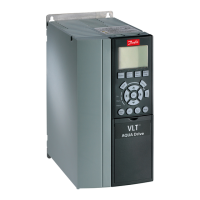handling. If a mains failure appears, the frequency
14-10 Mains Failure
Option: Function:
drops quickly. For larger frequency
converters, it only takes a few
milliseconds before the DC level
drops to about 373 V DC, and the
IGBTs cut o and lose the control of
the motor. When mains is restored,
and the IGBTs start again, the
output frequency and voltage
vector do not correspond to the
speed/frequency of the motor, and
the result is normally an
overvoltage or overcurrent, mostly
resulting in a trip lock.
Parameter 14-10 Mains Failure can
be programmed to avoid this
situation.
Select the function according to
which the frequency converter
must act when the threshold in
parameter 14-11 Mains Fault Voltage
Level is reached.
[0] * No function The frequency converter does not
compensate for a mains
interruption. The voltage on the
DC-link drops quickly and motor
control is lost within milliseconds to
seconds. Trip lock is the result.
[1] Ctrl. ramp-
down
Control of the motor remains with
the frequency converter, and the
frequency converter performs a
controlled ramp down from
parameter 14-11 Mains Fault Voltage
Level. If parameter 2-10 Brake
Function is [0] O or [2] AC brake,
the ramp follows the overvoltage
ramping. If parameter 2-10 Brake
Function is [1] Resistor Brake, the
ramp follows the setting in
parameter 3-81 Quick Stop Ramp
Time. This selection is useful in
pump applications, where the
inertia is low and the friction is
high. When mains is restored, the
output frequency ramps the motor
up to the reference speed (if the
mains interruption is prolonged, the
controlled ramp down may bring
the output frequency down to 0
RPM, and when the mains is
restored, the application is ramped
up from 0 RPM to the previous
reference speed via the normal
ramp up). If the energy in the DC-
